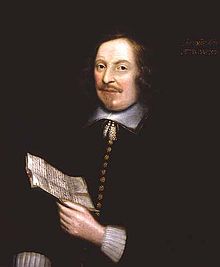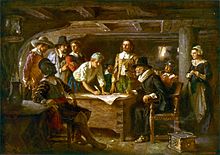Edward Winslow
Edward Winslow | |
|---|---|
 | |
| 3rd Governor of Plymouth Colony | |
| In office 1634–1648 | |
| Signature |  |
Edward Winslow (1595 – May 8, 1655) traveled on the Mayflower in 1620 so he could practice his own religion which was not allowed in England. Winslow helped to organize the voyage to the New World and was a leader at Plymouth Colony. He signed the Mayflower Compact[1][2][3]
Early life
[change | change source]Edward Winslow was born in Droitwich, Worcestershire England. His parents were Edward and Magdalene Winslow. In 1613 Winslow was apprenticed to a London printer. Winslow became a Separatist which was a religion that did not believe in the Church of England.[4][5][6]
It was illegal to be a Separatist in England, so in 1617 Edward Winslow moved to Leiden, Netherlands where he worked with William Brewster. They started to print religious booklets which were critical of the English king and his bishops. The English King ordered Brewster’s arrest, and he was forced to hide.
The Separatists were planning to move to America and they need leaders to plan the voyage.[7] Thomas Weston helped them by providing the ship Mayflower for their journey. Winslow's brother Gilbert and family servant George Soule and a youth, Elias Story went with him. Elinor (Ellen) More, a girl of eight years, also went with them[8][9] Elinor died in the winter of 1620 with only one brother Richard More surviving.[10]
Mayflower Voyage
[change | change source]Edward Winslow left Plymouth, England on 16 September 1620. There were 102 passengers and 30–40 crew. On 19 November 1620, the Mayflower spotted land at Cape Cod hook. They landed on November 21. They wrote the Mayflower Compact, which made rules on how they would live and treat each other. Winslow signed the Mayflower Compact.[11][12] The Mayflower was supposed to land in Virginia Colony, but the ship was too damaged and they were forced to land at Cape Cod now called Provincetown Harbor.[1][13]
In Plymouth Colony
[change | change source]

The men went to land to explore a place where they all could live. One of the missions included William Bradford, John Carver, Myles Standish, Edward Winslow, John Howland, Richard Warren, Stephen Hopkins and Edwary Doty. Bradford wrote that they set off in freezing weather and many of the men were ill. He said that "when the set sail the salt spray froze on their coats, as if they had been glazed". Of this group Hopkins was the most experienced, having seen Native Americans during his time at Jamestown. During their trip they saw Native Americans who were cutting up a large whale. When the Indians saw the men they ran away.[14]
Plymouth Colony lost over half of its population because of sickness, lack of proper food and the cold winter. With the help of friendly Native Americans, they learned to grow food. In 1621, Winslow and the others attended what would have the first Thanksgiving.[15] The next year they were able to load the ship Fortune with furs and other supplies. This was to pay the men would helped pay for the trip to the New World. On the return trip, the Mayflower was attacked by the French and all the cargo was taken.[16][17]
On February 21, 1621, William White died leaving a widow, Susanna, and two sons, Resolved and Peregrine. Edward Winslow had lost his wife Elizabeth on March 24, 1621. In 1621, Edward Winslow and Susanna White became the first couple to marry in Plymouth Colony.[18] They had 5 children: A (child) who died young, Edward Winslow, Josiah Winslow and Elizabeth. Josiah became the 13th Governor of Plymouth Colony.[19] [20]
Winslow had a friendship with native leader Massasoit. These Native Americans were friendly and helped the Pilgrims. In January 1629 a fishing and trading post opened up on the Kennebec River near Plymouth Colony. Isaac Allerton also opened his own trading post there and this caused problems between the two men.[21][22]
In 1632, Winslow explored the Connecticut River.[23]
Winslow was a diplomat and a spokesperson for the Pilgrims with English officials. Winslow was a governor in 1634, 1636 and 1644 and was a member of the United Colonies of New England. This was a military group which protected the pilgrims against unfriendly Native Americans.[22]
England had a civil war in the 1640s. Some pilgrims returned to fight against the King. In 1646, Winslow began working for Oliver Cromwell. Winslow never returned to Plymouth Colony.[24]
In 1654, Winslow fought against the Spanish in the West Indies. They won the battle but Winslow became ill and died from yellow fever. He was buried at sea.[25] Winslow Cemetery in Marshfield, Massachusetts has a stone monument which lists the names of the Winslow family. There is another memorial stone w/plaque stating "Edward Winslow, Founder of Marshfield". Edward Winslow's first wife Elizabeth Barker Winslow was buried in 1621 in the Cole's Hill Burial Ground, Plymouth, Massachusetts.[26][27][28]
References
[change | change source]- ↑ 1.0 1.1 George Ernest Bowman, The Mayflower Compact and its signers (Boston: Massachusetts Society of Mayflower Descendants, 1920). Photocopies of the 1622, 1646 and 1669 versions of the document pp. 7-19.
- ↑ Eugene Aubrey Stratton, Plymouth Colony: Its History and People, 1620-1691, (Salt Lake City: Ancestry Publishing, 1986), pp. 411-413
- ↑ William Bradford, History of Plymouth Plantation by 'William Bradford, the second Governor of Plymouth, (Boston: 1856), p. 306
- ↑ Robert Charles Anderson. Pilgrim Village Famiily Sketch: Edward Winslow (a collaboration of American Ancestors and New England Historic Genealogical Society)
- ↑ Len Travis, Oxford Dictionary of National Biography, Edward Winslow (1595–1655) (Oxford University Press, 2004), online edn, date October 2006, access date 2011-02-07
- ↑ Charles Edward Banks, ‘’The English Ancestry and Homes of the Pilgrim Fathers’’, (Grafton Press N.Y. 1929), pp. 98-99
- ↑ Nathaniel Philbrick, Mayflower: A story of Courage, Community and War, (New York: Viking 2006), p. 18
- ↑ Donald F. Harris, PhD., Mayflower Descendant, (July 1993), vol. 43 no. 2 pp. 1-5
- ↑ Donald F. Harris, PhD., Mayflower Descendant, (July 1993), vol. 43 no. 2, pp. 1-7
- ↑ David Lindsay, PhD., Mayflower Bastard: A Stranger amongst the Pilgrims, (New York: St. Martins Press, 2002), p. 29.
- ↑ Eugene Aubrey Stratton, Plymouth Colony: Its History and People, 1620-1691, (Salt Lake City: Ancestry Publishing, 1986), p. 413
- ↑ George Ernest Bowman, The Mayflower Compact and its signers, (Boston: Massachusetts Society of Mayflower Descendants, 1920). Photocopies of the 1622, 1646 and 1669 versions of the document pp. 7–19.
- ↑ Stratton, 20.
- ↑ Nathaniel Philbrick, Mayflower: A story of Courage, Community and War (New York: Viking 2006) p. 70
- ↑ Edward Winslow. Primary Sources for The First Thanksgiving at Plymouth Archived 2012-12-24 at the Wayback Machine. Pilgrim Hall Museum .
- ↑ Nathaniel Philbrick, Mayflower: A story of Courage, Community and War, (New York: Viking, 2006), p. 126, 135
- ↑ David Lindsay, PhD., Mayflower Bastard: A Stranger amongst the Pilgrims, (New York: St. Martins Press, 2002), Introduction, also p. 50
- ↑ William Bradford, ed. by Charles Deane, History of Plymouth Plantation by William Bradford, the second Governor of Plymouth, (Boston: 1856), p. 101
- ↑ Mayflower Families Through Five Generations: Descendants of the Pilgrims who landed at Plymouth Massachusetts, Dec., 1620: Family of William White, Originally compiled by Ruth Wilder Sherman, CG, FASG and Robert Moody Sherman, CG, FASG, Re-edited by Robert S. Wakefield, FASG, (Pub. by General Society of Mayflower Descendants 2006 3rd Edition), vol. 13, p. 5
- ↑ Nathaniel Philbrick, Mayflower: A story of Courage, Community and War, (New York: Viking, 2006), p. 104
- ↑ Nathaniel Philbrick, Mayflower: A Story of Courage, Community, and War, (New York: Viking, 2006), pp. 183-184
- ↑ 22.0 22.1 David Lindsay, PhD., Mayflower Bastard: A Stranger amongst the Pilgrims, (New York: St. Martins Press, 2002), pp. 72, 79, 137
- ↑ Albert Van Dusen, Connecticut (Random House 1961), p.19
- ↑ Mayflower Families Through Five Generations: Descendants of the Pilgrims who landed at Plymouth Massachusetts, Dec., 1620: Family of William White, Originally compiled by Ruth Wilder Sherman, CG, FASG and Robert Moody Sherman, CG, FASG, Re-edited by Robert S. Wakefield, FASG (Pub. by General Society of Mayflower Descendants 2006 3rd Edition), vol. 13, p. 2
- ↑ David Lindsay, PhD., Mayflower Bastard: A Stranger amongst the Pilgrims, (New York: St. Martins Press, 2002), p. 137
- ↑ Memorial for Edward Winslow
- ↑ Monument: Early Settlers of Green Harbor - Winslow/White
- ↑ Memorial for Elizabeth Barker Winslow
Further reading
[change | change source]- William Bradford, Edward Winslow (1865). Mourt’s Relation, or Journal of the Plantation at Plymouth. Boston: J. K. Wiggin. Reprint of the original version.
- J. D. Bangs's 'Pilgrim Edward Winslow: New England's First International Diplomat (Boston, 2004);
- Moore, Jacob B. (1846). Memoirs of American governors. New York: Gates & Stedman.
- Holton, David P.; Holton, Frances K. F. (1877). Winslow memorial. Family records of the Winslows and their descendants in America, with the English ancestry as far as known. New York: Holton.
- Palfrey, John G. (1859). History of New England, Vol. 1. Boston: Little, Brown.
- Palfrey, John G. (1860). History of New England, Vol. 2. Boston: Little, Brown.
- Palfrey, John G. (1865). History of New England, Vol. 3. Boston: Little, Brown.
- Plymouth Archaeological Rediscovery Project "Archaeology of the Edward Winslow Site" www.plymoutharch.com
- Also see a paper by W. C. Winslow, Governor Edward Winslow, his Place and Part in Plymouth Colony, in the Annual Report of the American Historical Association for 1895 (Washington, 1896)
- See Egerton Ryerson's The Loyalists of America and Their Times for evidence of the differences between the Pilgrim Fathers (Plymouth Rock) and the Puritan Fathers (Massachusetts Bay) with respect to loyalty to the Crown, tolerance of other religions, and treatment of the Native Peoples, and how this schism continued right up to and during the American Revolution.
Sources
[change | change source]- The Mayflower Society
Other websites
[change | change source]- "Winslow Homestead in Marshfield, Massachusetts". Winslow House. Retrieved 2011-02-07.
